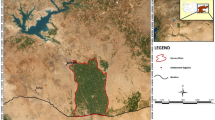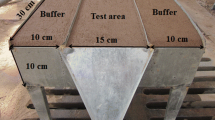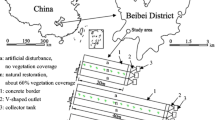Abstract
Irrigation-induced erosion in furrow irrigation causes loss of fertile soil and water quality degradation. Hence, quantification of irrigation-induced erosion is essential for efficient management of furrow irrigation. In this study, sediment transport was studied under bare and cropped field conditions for a furrow plot consisting of three parabolic shaped furrows of 40 m long and 0.5% slope. The inflow rates of 0.2, 0.3, 0.4 and 0.5 L s−1; and 0.3, 0.4, 0.5, 0.6 and 0.7 L s−1 were used for bare and cropped field conditions, respectively. The furrow cross section measured at every 5 m distance from the head end (before and after the irrigation event) was used to study the erosion pattern (erosion/deposition) along the furrow. The runoff collected at regular intervals of 10 min was used to study the sediment load. The total sediment export for an irrigation event was estimated using furrow cross-section data (FCD) and the sediment rate data (SRD), and compared with the total sediments collected at the tail end. For both bare and cropped conditions, soil erosion took place at the head and tail ends (free drain system), while the deposition occurred at the middle. The sediment transport increased initially and slightly decreased with time. A power relationship was obtained between the total sediment export and the inflow rate for bare furrow condition, whereas a linear relationship between these parameters was obtained for cropped field condition. The relative percentage errors suggested that both SRD and FCD methods can be used to estimate total sediment export from the field. The analysis (PSD) of the total sediments revealed that the geometric mean diameter of the sediment particle was 0.18 and 0.20 mm for bare and cropped field conditions, respectively.








Similar content being viewed by others
References
Agassi M, Letey J, Farmer WJ, Clark P (1995) Soil erosion contribution to pesticide transport by furrow irrigation. J Environ Qual 24:892–895
Berg ED, Carter DL (1980) Furrow erosion and sediment losses in irrigated cropland. J Soil Water Conserv 35:367–370
Bjorneberg DL, Trout TJ, Sojka RE, Aase JK (1999) Evaluating WEPP-predicted infiltration, runoff, and soil erosion for furrow irrigation. Trans ASAE 42:1733–1742
Brown MJ, Kemper WD, Trout TJ, Humpherys AS (1988) Sediment erosion and water intake in furrows. Irrig Sci 9:45–55
Carter DL, Berg RD, Sanders BJ (1985) The effect of furrow irrigation erosion on crop productivity. Soil Sci Soc Am J 49:207–211
Fernández Gómez R, Mateos L, Giráldez JV (2004) Furrow irrigation erosion and management. Irrig Sci 23:123–131
Fornstrom KJ, Borelli J (1984) Design and management procedure for minimizing erosion from furrow-irrigated cropland. Paper No. 84-2595. ASAE, St. Joseph, MI
Mailapalli DR, Raghuwanshi NS, Singh R, Schmitz GH, Lennartz F (2008) Spatial and temporal variation of Manning’s roughness coefficient in irrigation furrows. J Irrig Drain Eng 134(2):185–192
Mateos L, Giráldez JV (2005) Suspended load and bed load in irrigation furrows. Catena 64:232–246
Mech SJ, Smith DD (1967) Water erosion under irrigation. In: Hagan RM, Haise HR, Edminster TW (eds) Irrigation of agricultural lands. Agronomy monograph 11. ASA, Madison
Strelkoff TS, Fernández Gómez R, Mateos L, Giráldez JV, Clemmens AJ (2002) On tracking sediment particle sizes in furrow irrigation induced erosion for modeling phosphorus transport. In: Conference on energy, climate, environment and water: issues and opportunities for irrigation and drainage. July 9–12, 2002, San Luis Obispo, California
Trout TJ (1996) Furrow irrigation erosion and sedimentation: on-field distribution. Trans ASAE 39(5):1717–1723
Trout TJ (2001) Sediment transport in irrigation furrows. In: Stott DE, Mohtar RH, Steinhardt GC (eds) Sustaining the global farm: selected papers from the 1999 International Soil Conservation Organization meeting. W. Lafayette, IN, 24–29 May, 1999, pp 710–716
Trout TJ, Neibling WH (1993) Erosion and sedimentation process on irrigated fields. J Irrig Drain Eng 119(6):947–963
Acknowledgments
The Volkswagen Foundations, Germany under the Joint Research Programmes of the Natural, Engineering and Economic Sciences with Institutes in Africa, Asia and Latin America funded this research project. The financial support of the foundation is greatly acknowledged.
Author information
Authors and Affiliations
Corresponding author
Additional information
Communicated by T. Trooien.
Rights and permissions
About this article
Cite this article
Mailapalli, D.R., Raghuwanshi, N.S. & Singh, R. Sediment transport in furrow irrigation. Irrig Sci 27, 449–456 (2009). https://doi.org/10.1007/s00271-009-0160-5
Received:
Accepted:
Published:
Issue Date:
DOI: https://doi.org/10.1007/s00271-009-0160-5




